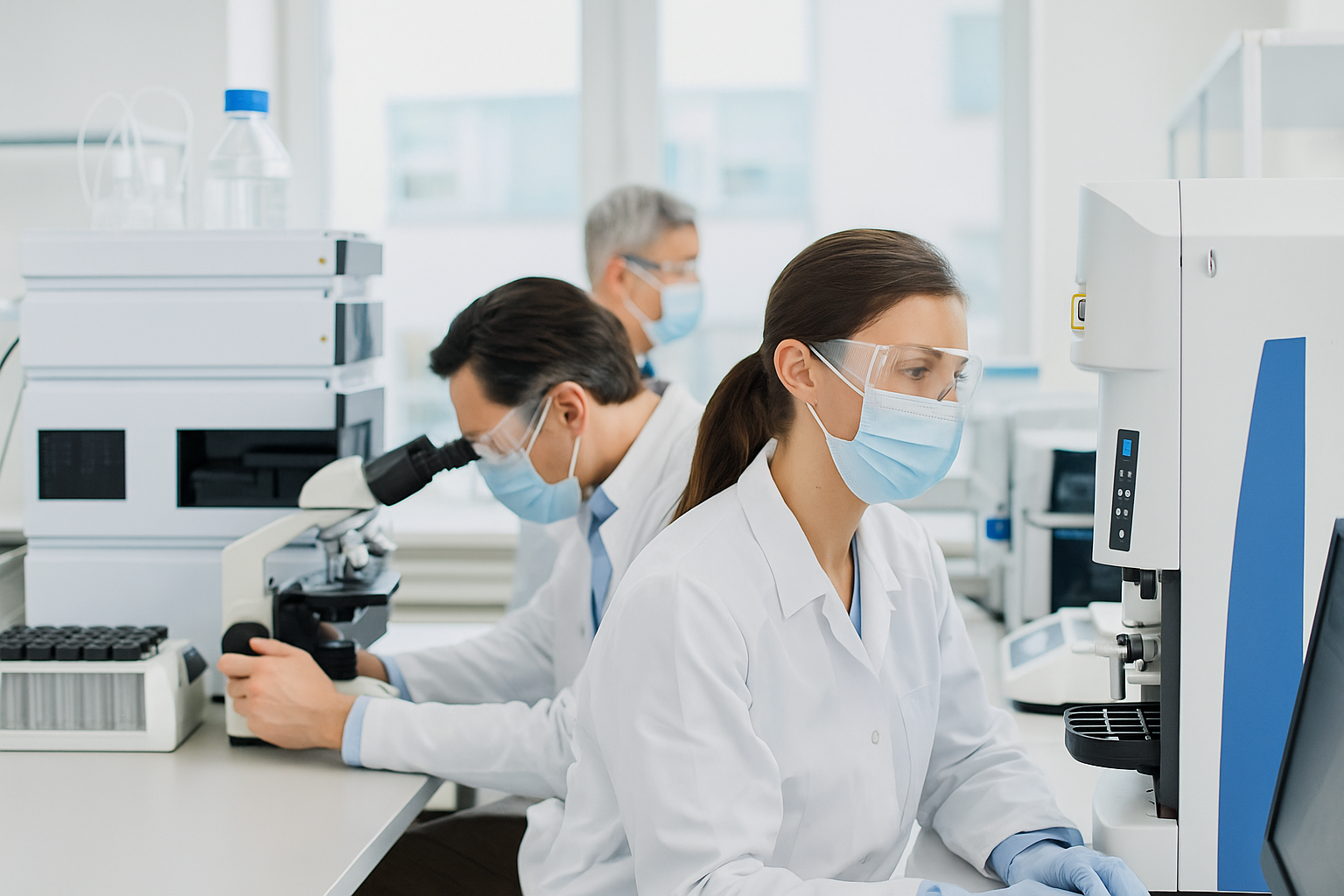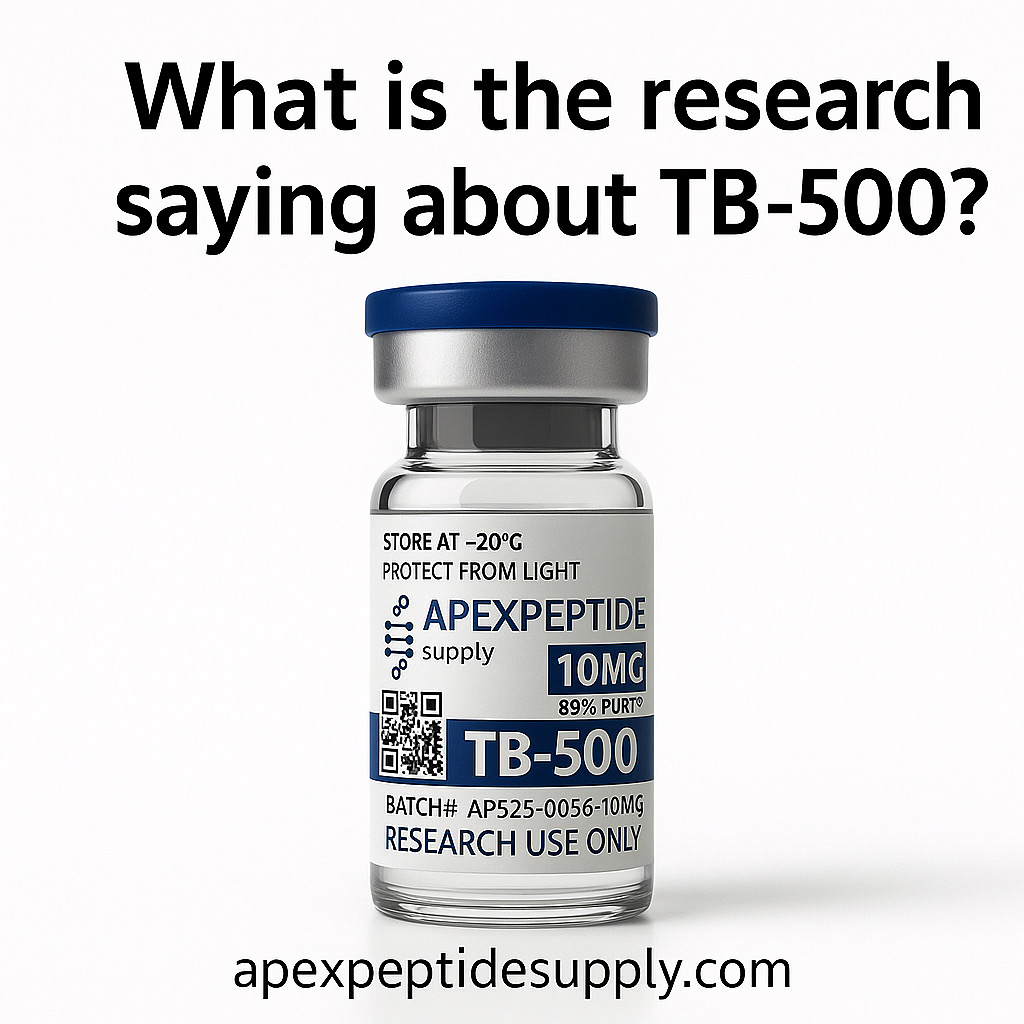HPLC & Mass Spectrometry Testing for Peptides: Ensuring Purity, Accuracy, and Research Confidence
Matthew Jensen • August 16, 2025
How HPLC and Mass Spectrometry Confirm Peptide Quality and Why It Matters for Research

Introduction
When it comes to peptide research, purity and accuracy are everything. Scientists, labs, and research organizations all rely on dependable data, and that starts with knowing that the peptide in the vial is exactly what it’s supposed to be. That’s where HPLC (High-Performance Liquid Chromatography) and MS (Mass Spectrometry) testing come in. These two gold-standard methods are the backbone of modern laboratory analysis, ensuring peptides are pure, properly identified, and ready for reliable experiments.
In this article, we’ll break down what HPLC and MS testing are, how they work, and why they matter — in simple, easy-to-understand terms.
What is HPLC Testing?
High-Performance Liquid Chromatography (HPLC) is a technique used to separate and measure the purity of compounds in a mixture.
Here’s how it works in plain English:
Imagine you have a smoothie with many different fruits blended together. HPLC is like running that smoothie through a filter that separates each fruit back into layers.
For peptides, HPLC separates all the molecules present in a sample, showing whether it’s made up of mostly the peptide you want — or if there are unwanted byproducts left over from synthesis.
Why it matters for peptides:
Confirms purity percentage (for example, “98% pure”).
Detects any impurities or residual solvents.
Ensures the peptide meets research standards for reproducibility.
What is Mass Spectrometry (MS) Testing?
Mass Spectrometry (MS) is all about measuring the exact molecular weight of a compound.
Here’s the simple version:
Think of it like weighing a diamond on a scale that’s so precise it can tell the difference between a real diamond and a fake one.
MS “weighs” your peptide molecule at the atomic level and confirms that the peptide sequence is exactly what it should be.
Why it matters for peptides:
Confirms molecular identity by matching the observed mass to the theoretical mass.
Detects modifications or errors in synthesis.
Provides researchers with confidence that the peptide sequence is correct.
Why Both Tests Are Important Together
HPLC and MS are complementary.
HPLC tells you how pure the peptide is.
MS tells you what it is.
Together, they form the basis of a Certificate of Analysis (COA)
— the official document that accompanies legitimate research-grade peptides. Without both, researchers can’t be fully confident in the quality or reproducibility of their work.
Why This Matters for Research
When researchers run experiments, they need accuracy and consistency. Impure or misidentified peptides can lead to wasted time, incorrect conclusions, or unreliable data. By using peptides verified through HPLC and MS testing, labs can:
Trust the identity and purity of the compound.
Ensure reproducibility across experiments.
Maintain compliance with research standards and publication requirements.
Where You Can Learn More
If you’d like to dive deeper into peptide testing, here are some useful resources:
National Center for Biotechnology Information (NCBI) – Search for studies on HPLC and MS methods.
ScienceDirect – Peer-reviewed research articles on analytical chemistry and peptide testing.
Journal of Chromatography – Leading journal focused on HPLC techniques.
Conclusion
Peptide research is only as strong as the tools behind it — and that starts with testing. HPLC and Mass Spectrometry
provide the gold-standard assurance that what’s in the vial is pure, accurate, and exactly what the label says.
At Apex Peptide Supply, every peptide is verified through HPLC and MS testing, giving researchers confidence in their work and reliable results every time.
⚠️ Disclaimer: For Research Use Only. Not for human consumption.

Introduction Peptides have become an exciting area of focus in modern research, especially for their role in cellular repair and regeneration studies. These short chains of amino acids act as biological messengers, influencing a wide range of processes within the body, from cell signaling to tissue regeneration. In laboratory environments, researchers are exploring how peptides interact with cells to better understand mechanisms like wound healing, mitochondrial activity, and neurological pathways. This growing body of research is providing valuable insights that could shape the future of scientific discovery in fields ranging from molecular biology to cosmetic science. Compliance Disclaimer: All peptides discussed in this article are provided for laboratory research purposes only. They are not intended for human consumption, therapeutic use, or clinical applications. This article is for educational purposes only and does not provide medical advice or health recommendations. The Role of Peptides in Cellular Repair Cellular repair is essential for maintaining the structure and function of living tissues. Damage to cells can occur due to oxidative stress, environmental factors, or natural aging processes. In research settings, peptides are being studied for their potential to influence these processes by acting as signaling molecules that guide cellular behavior. For example: - Certain peptides are being examined for their role in angiogenesis—the formation of new blood vessels—which is crucial in wound healing models and tissue growth studies. - Others are studied for their neurological effects, helping researchers better understand cognitive function, stress responses, and sleep regulation in controlled laboratory environments. - Some peptides, like NAD+ and MOTS-c, are being researched for their role in mitochondrial health, giving scientists deeper insights into energy production and cellular longevity pathways. Recent peer-reviewed studies have highlighted the promise of peptides in advancing basic scientific knowledge. For instance, a 2020 study published in Frontiers in Pharmacology investigated BPC-157's effects on angiogenesis and tissue regeneration in pre-clinical models, underscoring its relevance in laboratory research. Similarly, research into MOTS-c, published in Cell Metabolism, explored its role in metabolic signaling and mitochondrial activity. Key Research Peptides and Their Areas of Study Peptide Scientific Focus Typical Areas of Study Example Study BPC-157 Angiogenesis, tissue Soft tissue and Front Pharmacol. 2020;11:1013 regeneration, and wound healing models cytoprotection TB-500 (Thymosin Actin binding, Recovery, injury Ann NY Acad Sci. 2010;1194:87-97 Beta-4) cellular migration, modeling, and regenerative and tissue repair pathways GHK-Cu Collagen synthesis Cosmetic and dermatological J Cosmet Dermatol. 2018;17 and copper peptide models interactions MOTS-c Mitochondrial Metabolic pathway Cell Metab. 2015;21(3):443-454 signaling and and aging research metabolic regulation NAD+ Cellular energy Aging, Nature Commun. 2016;7:13103 production and mitochondrial, and redox reactions metabolic studies CJC-1295 Growth hormone- Pituitary function Clin Endocrinol (Oxf). 2006;64(3):307-314 releasing hormone and endocrine (GHRH) analog signaling research DSIP Neuromodulator Sleep regulation Peptides. 2008;29(10):1873-1886 linked to sleep and studies in controlled circadian rhythms lab settings Snap-8 Peptide analog Cosmetic wrinkle J Cosmet Sci. 2014;65(1):19-24 studied for botulinum-like reduction research mechanisms Sermorelin GHRH analog for Pediatric endocrine J Clin Endocrinol Metab. 1986;62(6):1241-1246 pituitary and and pituitary gland growth hormone research pathway studies Ipamorelin Growth hormone- Endocrine signaling Growth Horm IGF Res. 2001;11 Suppl A:S1-8 releasing peptide and metabolic (GHRP) exploration Selank Synthetic peptide Neurological and Bull Exp Biol Med. 2008;146(5):585-587 with potential cognitive models anxiolytic effects Semax Synthetic nootropic Neuroprotection Front Neurosci. 2020;14:1074 peptide and cognition studies Glutathione Antioxidant Oxidative stress and Nutrients. 2017;9(8):841 tripeptide involved cellular defense in detoxification studies The Importance of Purity and Third-Party Testing in Peptide Research In laboratory research, accuracy and reproducibility are non-negotiable. Even slight variations in a compound's purity or composition can lead to inconsistent data, wasted resources, and compromised studies. This is especially true with peptides. High-Performance Liquid Chromatography (HPLC) is used to confirm peptide purity, ensuring that no unintended compounds are present, while Mass Spectrometry (MS) provides a molecular fingerprint of the compound. These methods together confirm that the peptide matches its documented profile. Certificates of Analysis (COAs) provide detailed documentation of a peptide's purity, molecular weight, and batch-specific data. At Apex Peptide Supply, each vial is paired with a unique QR code linking directly to its corresponding COA for full transparency. Compliance and Ethical Research Practices Peptide research holds tremendous potential for advancing scientific understanding, but with this potential comes responsibility. Every peptide provided by Apex Peptide Supply is for laboratory research purposes only and is not intended for human consumption, therapeutic use, or clinical applications. Clear labeling and QR-coded COAs help maintain transparency and compliance with federal guidelines. Conclusion: Your Trusted Source for Laboratory-Grade Peptides For researchers dedicated to advancing knowledge in cellular repair and peptide science, quality and transparency are essential. Apex Peptide Supply exists to meet this need by providing high-purity, third-party tested peptides with full COA documentation. Visit apexpeptidesupply.com to learn more about our quality standards and explore our catalog of laboratory-grade research peptides. Final Compliance Statement: This blog is for educational purposes only and does not make claims regarding therapeutic use or safety of peptides. All products are for research use only and not intended for human or animal consumption.

